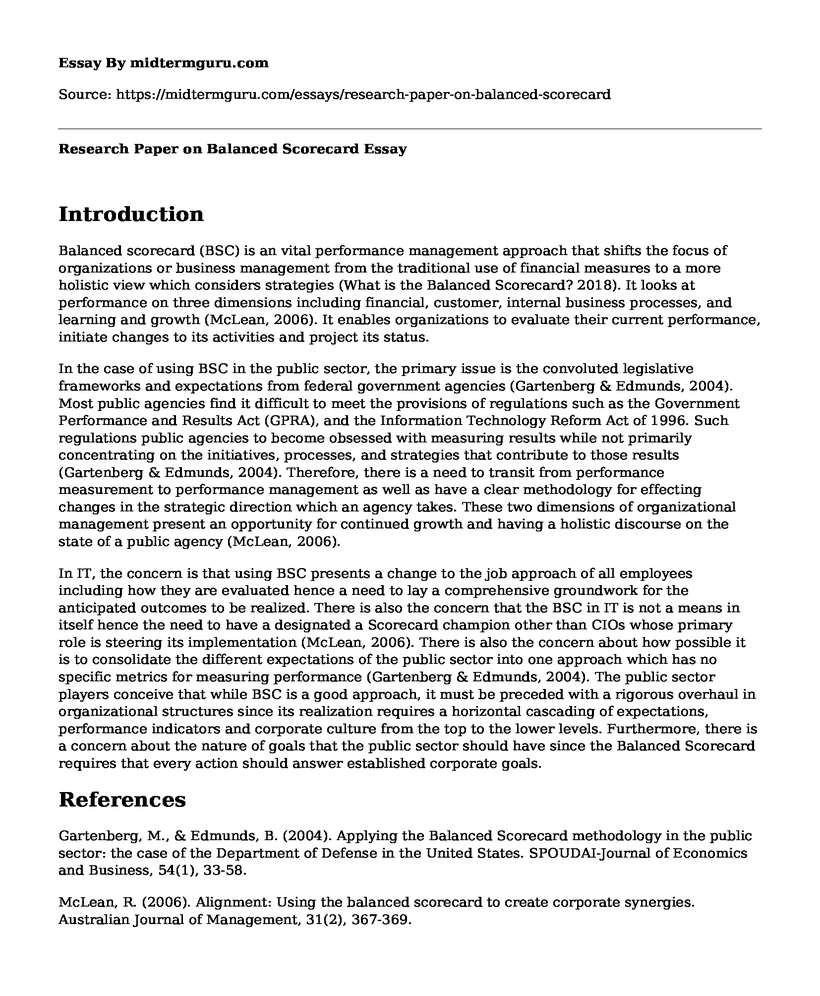Introduction
Balanced scorecard (BSC) is an vital performance management approach that shifts the focus of organizations or business management from the traditional use of financial measures to a more holistic view which considers strategies (What is the Balanced Scorecard? 2018). It looks at performance on three dimensions including financial, customer, internal business processes, and learning and growth (McLean, 2006). It enables organizations to evaluate their current performance, initiate changes to its activities and project its status.
In the case of using BSC in the public sector, the primary issue is the convoluted legislative frameworks and expectations from federal government agencies (Gartenberg & Edmunds, 2004). Most public agencies find it difficult to meet the provisions of regulations such as the Government Performance and Results Act (GPRA), and the Information Technology Reform Act of 1996. Such regulations public agencies to become obsessed with measuring results while not primarily concentrating on the initiatives, processes, and strategies that contribute to those results (Gartenberg & Edmunds, 2004). Therefore, there is a need to transit from performance measurement to performance management as well as have a clear methodology for effecting changes in the strategic direction which an agency takes. These two dimensions of organizational management present an opportunity for continued growth and having a holistic discourse on the state of a public agency (McLean, 2006).
In IT, the concern is that using BSC presents a change to the job approach of all employees including how they are evaluated hence a need to lay a comprehensive groundwork for the anticipated outcomes to be realized. There is also the concern that the BSC in IT is not a means in itself hence the need to have a designated a Scorecard champion other than CIOs whose primary role is steering its implementation (McLean, 2006). There is also the concern about how possible it is to consolidate the different expectations of the public sector into one approach which has no specific metrics for measuring performance (Gartenberg & Edmunds, 2004). The public sector players conceive that while BSC is a good approach, it must be preceded with a rigorous overhaul in organizational structures since its realization requires a horizontal cascading of expectations, performance indicators and corporate culture from the top to the lower levels. Furthermore, there is a concern about the nature of goals that the public sector should have since the Balanced Scorecard requires that every action should answer established corporate goals.
References
Gartenberg, M., & Edmunds, B. (2004). Applying the Balanced Scorecard methodology in the public sector: the case of the Department of Defense in the United States. SPOUDAI-Journal of Economics and Business, 54(1), 33-58.
McLean, R. (2006). Alignment: Using the balanced scorecard to create corporate synergies. Australian Journal of Management, 31(2), 367-369.
What is the Balanced Scorecard? (2018). Retrieved from https://www.balancedscorecard.org/BSC-Basics/About-the-Balanced-Scorecard
Cite this page
Research Paper on Balanced Scorecard. (2022, Nov 04). Retrieved from https://midtermguru.com/essays/research-paper-on-balanced-scorecard
If you are the original author of this essay and no longer wish to have it published on the midtermguru.com website, please click below to request its removal:
- Dominos Pizza Company Analysis - Paper Example
- Affiliative Leadership Style - Management Essay Example
- Summarize Bass' Leadership Approaches - Paper Example
- Assignment Example on Workplace Safety
- Essay Sample on Effective Communication and Teamwork in Regards to Ideas From Johari Window
- Comparing Obama and Isocrates's Speech - Essay Sample
- Nurse Leadership: Essential Competencies for Success in Healthcare - Essay Sample







